Haliaeetus leucogaster (Gmelin, 1788)
IUCN
LCBasic Information
Scientific classification
- name:Haliaeetus leucogaster (Gmelin, 1788)
- Scientific Name:Haliaeetus leucogaster (Gmelin, 1788),White-bellied Sea Eagle,White-bellied Eagle, White-tailed Eagle
- Outline:Raptor
- Family:Falconiformes Accipitridae Accipitrinae S.Eagle
Vital signs
- length:70-85cm
- Weight:3-5kg
- lifetime:15-40years
Feature
It has a simple call and is an excellent hunter both at sea and on land.
Distribution and Habitat
Distributed in Australia, Bangladesh, Brunei, Cambodia, China, India, Indonesia, Lao People's Democratic Republic, Malaysia, Myanmar, Papua New Guinea, Philippines, Singapore, Sri Lanka, Thailand, East Timor, Vietnam.
Migrant bird: Christmas Island, Taiwan Island, China.
In China, it is distributed in Jiangsu, Zhejiang, Fujian, Guangdong, Hong Kong, Hainan, Taiwan and other places, but it is extremely rare in all places. Hainan is an early record in the 1930s, and Taiwan is an occasional stray bird.
The white-bellied sea eagle is a resident bird, active in coastal and estuary areas, and sometimes appears over hills and reservoirs not far from the coast, but generally does not go far from the coast. Therefore, it is a typical coastal bird and an excellent hunter at sea and on land.
Appearance
The wings are wide and long, the tail is short, the head, neck and lower body are white, and the back is black gray. The tail feathers are wedge-shaped, brown in color with white ends, which is one of the main features that distinguishes it from other sea eagles. Viewed from below when flying, except for the bases of the flight feathers and tail feathers which are black, the rest are all white. Black and white are distinct and extremely eye-catching. In flight, the black wings contrast sharply with the white belly. Like all members of the genus Erythropus, its tail is short and wedge-shaped.
The iris is brown, the wax membrane and the upper beak are red-gray, the lower beak is blue-gray with a black tip, the beak cleft is red-blue, the tarsometatarsus and toes are light flesh-colored, and the claws are black. The head, neck and lower body are white, and the back feathers are gray-brown; the tail is wedge-shaped, the base 1/3 is gray-black, and the rest is white; the shoulder and win
Details
White-bellied Sea Eagle is a large bird of prey with no subspecies.

White-bellied Sea Eagle usually flies alone or in pairs along the coast at low altitudes over the water, flapping its wings slowly and powerfully, and sometimes soaring and gliding in the sky. When soaring or gliding in the sky, the wings are often raised in a "V" shape. Sometimes they also live in trees in open areas or higher on the ground. They forage for food both at sea and over land, often flying along the sea surface.
The breeding season of the white-bellied sea eagle is from December to March of the following year, and in Australia and other places in the southern hemisphere, it is usually from May to October. Generally, the nests are built on tall trees or cliff rocks on the coast, and also on small trees in inland swamps, on the ground or rocks on treeless islands. The structure of the nest is relatively large, with a diameter of up to 250 cm. It is mainly composed of dead branches, with some green leaves inside. They also like to use old nests. Usually a nest can be used for many years, but new nest materials need to be added every year. Therefore, the nest becomes larger and larger as the years of use increase. A nest with a diameter of 270 cm and a height of 180 cm was found in India. Each nest usually lays 2 eggs, occasionally 3 eggs. The eggs are white and oval in shape. The parents take turns to incubate the eggs, but the female is the main one, and the male only replaces the female during the day. The territoriality is very strong, and the parents also defend it together.
Habitat loss, food reduction and overhunting are all factors that have led to the decline in the population of white-bellied sea eagles.
Listed in the 2012 Red List of Endangered Species of the World Conservation Union (IUCN) ver3.1 - Least Concern (LC).
Listed in Appendix II of the Washington Convention on International Trade in Endangered Species (CITES).
Listed as a Class II national key protected animal in China.
Listed as a rare species in the "China Red Book of Endangered Animals·Birds".
Listed as the first-level "List of National Key Protected Wildlife in China".
Protect wild animals and eliminate game.
Maintaining ecological balance is everyone's responsibility!








